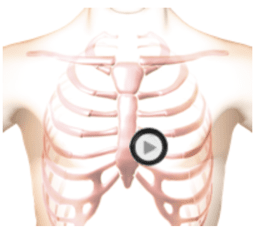Severe Tricuspid Regurgitation Lesson
Where to Auscultate


The patient was supine during auscultation.
Description
This recording is an example of severe tricuspid regurgitation. The first heart sound is normal and S2 is unsplit. A loud, rectangular, pansystolic murmur is present as well as a brief, rumbling, diamond-shaped diastolic murmur. In the cardiac animation video, observe the enlarged right atrium and right ventricle. Notice the turbulent blood flow from the right ventricle into the right atrium. This is the systolic murmur. Observe the brief turbulent blood flow from the right atrium to the right ventricle in diastole. This is caused by too much blood in the right atrium which forces blood back into the ventricle during diastole producing the flow rumble. To differentiate tricuspid regurgitation from mitral regurgitation, the maximum intensity of the tricuspid murmur is heard at the left lower sternal border. In addition, the murmur intensity increases with inspiration.
Phonocardiogram
Anatomy
Severe Tricuspid Regurgitation
Authors and Sources
Authors and Reviewers
-
Heart sounds by Dr. Jonathan Keroes, MD and David Lieberman, Developer, Virtual Cardiac Patient.
- Lung sounds by Diane Wrigley, PA
- Respiratory cases: William French
-
David Lieberman, Audio Engineering
-
Heart sounds mentorship by >W. Proctor Harvey, MD
- Special thanks for the medical mentorship of Dr. Raymond Murphy
- Reviewed by Dr. Barbara Erickson, PhD, RN, CCRN.
-
Last Update: 11/10/2021
Sources
-
Heart and Lung Sounds Reference Library
Diane S. Wrigley
Publisher: PESI -
Impact Patient Care: Key Physical Assessment Strategies and the Underlying Pathophysiology
Diane S Wrigley & Rosale Lobo - Practical Clinical Skills: Lung Sounds
- PESI Faculty - Diane S Wrigley
-
Case Profiles in Respiratory Care 3rd Ed, 2019
William A.French
Published by Delmar Cengage -
Essential Lung Sounds
by William A. French
Published by Cengage Learning, 2011 -
Understanding Lung Sounds
Steven Lehrer, MD
-
Clinical Heart Disease
W Proctor Harvey, MD
Clinical Heart Disease
Laennec Publishing; 1st edition (January 1, 2009) -
Heart and Lung Sounds Reference Guide
PracticalClinicalSkills.com